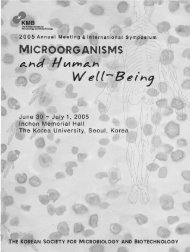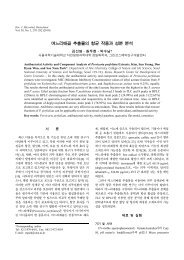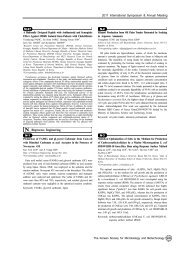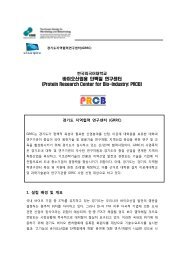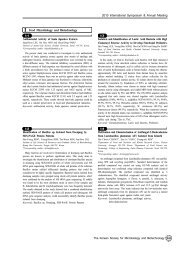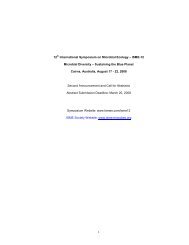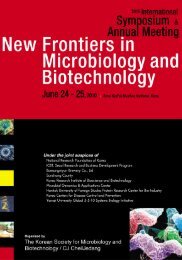J_Environmetal Microbiology and Engineering
J_Environmetal Microbiology and Engineering
J_Environmetal Microbiology and Engineering
Create successful ePaper yourself
Turn your PDF publications into a flip-book with our unique Google optimized e-Paper software.
Identification of Novel Sugar Pathway Genes <strong>and</strong> their<br />
Organization from an Insect Gut Metagenome<br />
Chang-Muk LEE* 1 , Sang-Hong YOON 1 , Soo-Jin KIM 2 , So-Hyeon SEO 1 ,<br />
Young-Seok LEE 1 , Jung-Keun PARK 1 , Han-Chul KANG 1 <strong>and</strong><br />
Bon-Sung KOO 1<br />
J-24<br />
1<br />
Functional Biomaterial Division, National Academy of Agricultural Science,<br />
2<br />
Rural Development Administration, Suwon 441-707, Korea. National<br />
Agrobiodiversity Center, Academy of Agricultural Science, Rural Development<br />
Administration, Suwon 441-707, Korea.<br />
*Corresponding author: changmuk@rda.go.kr<br />
Insect gut symbiotic microbiota play essential roles in the recycling<br />
various organic materials, <strong>and</strong> may thus be exploited as a simple system<br />
for processing daily food wastes. To detect the contributing microbial<br />
genes, we have constructed 92,544 metagenomic fosmid clones using the<br />
larval intestinal microbiome from black soldier fly, Hermetia illucens.<br />
The hydrolytic enzymes encoded by uncultured microorganisms were<br />
subjected to substrate hydrolysis analysis. Initial screening of the libraries<br />
revealed a clone that uses carboxymethyl cellulose as a sole carbon source.<br />
Functional screening <strong>and</strong> metagenome walking with shot-gun libraries<br />
revealed two novel gene clusters conferring multiple sugar pathways. The<br />
cluster was 36kb in size <strong>and</strong> transcribed as polycistronic units. They<br />
include glycosidase-related sugar pathway genes that are arranged as sugar<br />
transferase genes, glycan processing genes, transporter genes, <strong>and</strong> putative<br />
transcription factors. The presence of insertion sequences between clusters<br />
suggests that the metagenome-derived clone has acquired the specific<br />
organization by lateral gene transfer [Supported by grants from the Rural<br />
Development Administration project number PJ0067032011].<br />
Keywords: Metagenome, Hermetia illucens gut, Glycosidase<br />
Development of Transgenic Daphnia magna Expressing Enhanced<br />
green Fluorescent Protein<br />
Thai Hoang LE 1 , Sung-Kyu LEE 2 , Yang-Hoon KIM 3 <strong>and</strong> Jiho MIN* 1<br />
1<br />
Department of Bioprocess <strong>Engineering</strong>, Chonbuk National University, 664-14<br />
Duckjin-dong, Jeonju 561-756, South Korea. 2 Toxicology Research Center, Korea<br />
Research Institute of Chemical Technology, Daejon, 305-600, Korea. 3 J-25<br />
School of<br />
Life Science, Chungbuk National University 410 Sungbong-Ro, Heungduk-Gu,<br />
Cheongju 361-763, South Korea.<br />
*Corresponding author: jihomin@jbnu.ac.kr<br />
To establish a novel system for a rapid detection of environmental stress,<br />
a transgenic Daphnia magna able to express a green fluorescent protein<br />
has been created. A 32bp DNA fragment containing the 18s-ribosome<br />
constitute promoter of daphnia was generated by in-vitro annealing the<br />
commercial primers at 80 o C. This target DNA was inserted ahead to the<br />
gfp gene in the EGFP vector (Enhanced Green Flourescent Protein). The<br />
successful recombinant plasmid confirmed by the DNA sequencing was<br />
introduced into the earlier developing-state daphnia eggs (round shape)<br />
using microinjection technique. After 48h incubation in the 20 o C chamber,<br />
the injected eggs able to develop to juveniles were observed at the 488nm<br />
wavelength in the confocal fluorescent microscope to confirm the presence<br />
of green fluorescent protein. Our results show that the green fluorescent<br />
protein was substantially found in the upper part of the transgenic<br />
organisms (e.g., head, back) while no fluorescent signal was detected in<br />
the control organism. It demonstrated that a transgenic Daphnia magna<br />
expressing green fluorescent protein was firstly generated <strong>and</strong> would be<br />
promising to build a novel testing system for easily monitoring<br />
environmental stress.<br />
Keywords: Daphnia magna, transgenic, fluorescent<br />
402 www.kormb.or.kr<br />
Isolation <strong>and</strong> Characteristics of Antagonic Microorganisms as<br />
Nematicide Against Root-knot Nematode of Fruit Vegetables<br />
(Oriental Melon <strong>and</strong> Cucumber)<br />
Beam Soo KIM 1 , Keun-Hyung LEE 1 , Young-Won KANG 1 , Chang-Su KIM 1 ,<br />
Se-Ho MYEONG 1 , Joung-Ja KWON 2 , Chung-Sig CHOI 3 <strong>and</strong><br />
Gi-Seok KWON* 1<br />
1<br />
School of Bioresource Sciences, Andong National University, Andong 760-749,<br />
Korea. 2 Cheongsong Agricultural Technology Center Cheong Song Gun,<br />
CheongSong 763-802, Korea. 3 J-26<br />
Bio Industry Institute, HansBio Co.,Ltd. Andong<br />
760-380, Korea.<br />
*Corresponding author: suyaa18@hanmail.net<br />
This study was conducted to screen the antagonic microorganisms on<br />
root-knot nematode <strong>and</strong> to utilize in its control. The effect of nematocidal<br />
activity of antagonic microorganisms were tested on the nematicide of<br />
root-knot nematode, Showing nematocidal activities of 88 strains isolated<br />
from various fruit Vegetables field <strong>and</strong> soil. In vitro study, all tested<br />
treatments had nematicidal effect on nematode juveniles 24 <strong>and</strong> 48 hours<br />
from exposures in the 24-well plate. Among them, BS-17, BS-51(2),<br />
BS-51(3), BS-52(2), <strong>and</strong> BS-84(2) were isolated. The highest percentage<br />
of nematode mortality was achieved by application of BS-17(96.38%),<br />
BS-51(2)(94.11%), BS-51(3)(95.38%), BS-52(2)(94.59%), BS-84(2)<br />
(98.48%). Under greenhouse conditions, isolated antagonic microorganisms<br />
treatments were effective in reducing population numbers of root-knot<br />
nematode <strong>and</strong> root gall formation in compared to non-treatments.<br />
Keywords: Root-knot nematode, Meloidogyne. Antagonic microorganisms,<br />
Nematocidal activity, Ne<br />
Effect of Plant Growth-Promoting Rhizobacteria on Growth of<br />
Chinese cabbage Plant under Salt Stress<br />
Hee Sun KOOK 1 , Gun-Woon LEE 1 , Song-Joong YUN 2 , Jong-Chan CHAE 1<br />
<strong>and</strong> Kui-Jae LEE* 1<br />
J-27<br />
1<br />
Division of Biotechnology, Chonbuk national University, Iksan 570-752, korea.<br />
2<br />
Division of Agriculture Life sciences, Chonbuk National University, Chonju<br />
561-765, Korea.<br />
*Corresponding author: k722954@naver.com<br />
To gain underst<strong>and</strong>ing of responses to salinity stress by rhizobacteria<br />
at physiological level, we isolated 15 strains of plant growth-promoting<br />
bacteria from soil samples taken in the reclaimed tidel<strong>and</strong>s. These 15<br />
strains have been identified as Pseudomonas, Herbaspirillum, Enterobacter,<br />
Serratia, <strong>and</strong> Stenotrophomonas by 16S rRNA gene sequence analysis.<br />
With the exception of Serratia sp., all strains can product indole acetic<br />
acid (IAA) <strong>and</strong> IBA (butyric acid). Among the selected 15 strains, eight<br />
strains only showed 1-aminocyclopropane-1-carboxylate (ACC)<br />
deaminase activity <strong>and</strong> rhizobacterial ACC deaminases were detected by<br />
polyclonal anti-ACCD antibody. To evaluate whether rhizobacteria<br />
inhabiting saline environments confer the resistance against salt stress to<br />
Chinese cabbage plant, cabbage seeds were sown in soil inoculated with<br />
respective bacterial strains. And then, the early seedling growth was<br />
examined under 0 or 100 mM NaCl solution treatment for 2 weeks after<br />
germination. Results of our study exhibited that inoculation with selected<br />
strains increased the shoot length ranging from 107 to 141%, compared<br />
to that of the uninoculated control. These results indicate that the<br />
rhizobacterial stains had the potential to promote the growth of cabbage<br />
plant under saline condition.<br />
Keywords: plant growyh-promoting rhizobacteria (PGPR), Chinese cabbage,<br />
NaCl, Salt stress







